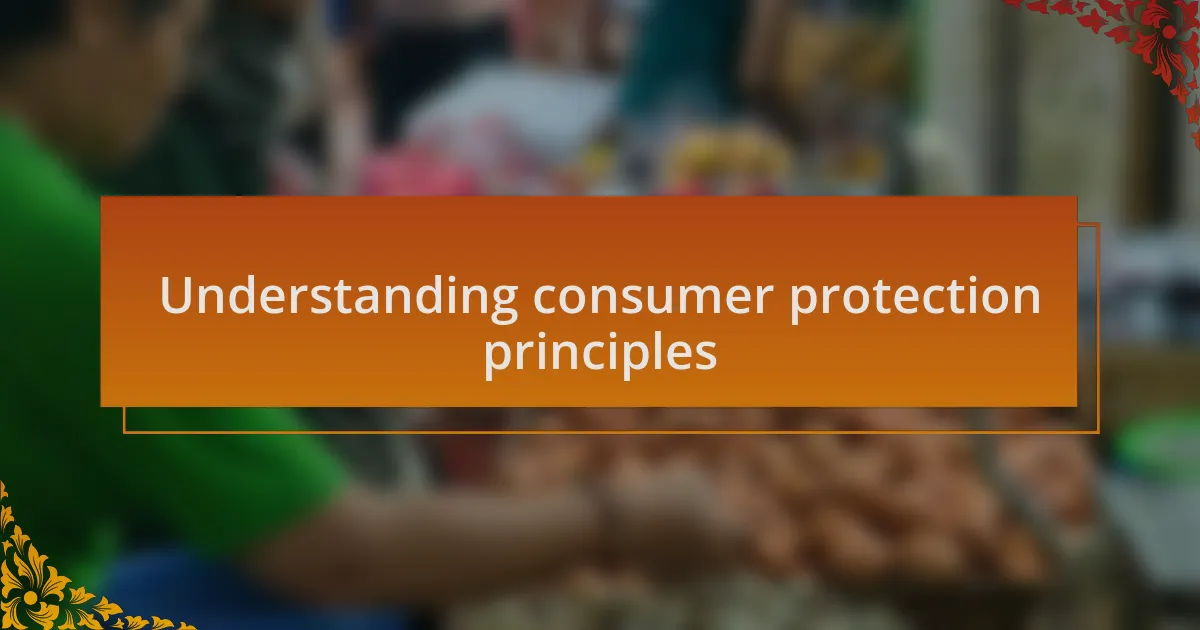Key takeaways:
- Consumer protection relies on informed choice, transparency, and reliable practices to empower consumers.
- Culture shapes perceptions and behaviors, influencing how safety and trust are viewed in various environments.
- Preferences in consumer behavior are impacted by cultural values, affecting choices regarding products and brands.
- Brands must understand cultural nuances to effectively engage with their target markets and avoid mistrust.

Understanding consumer protection principles
Consumer protection principles are foundational to ensuring that individuals can navigate markets safely and confidently. I remember my first experience with a questionable product—a gadget that promised to simplify my life but instead complicated it. It was then I truly understood the importance of transparency and reliability in consumer goods. How often do we trust a brand because of how it markets itself, only to discover that trust was misplaced?
At the heart of consumer protection is the notion of informed choice. Have you ever considered how much information we’re often bombarded with when making a purchase? For me, skimming through endless reviews or fine print can feel overwhelming, yet it’s essential. By focusing on the need for clarity and accessibility, companies can create an environment where consumers feel empowered to make decisions that truly reflect their needs.
Additionally, enforcing fair practices is crucial in maintaining consumer trust. I once faced a situation where a service provider didn’t honor their advertised warranty. That experience underscored for me how vital regulatory frameworks are in safeguarding consumers. Without robust enforcement of these principles, how can we expect consumers to feel safe when making their choices?

Exploring the concept of culture
Culture profoundly shapes our perceptions, behaviors, and interactions, extending far beyond mere traditions or customs. I remember when I traveled abroad for the first time and found myself navigating different social norms—like how greeting someone with a smile could mean warmth in some cultures but might be perceived differently in others. This realization struck me deeply; culture informs not just what we value but also how we feel safe and respected in various environments.
At its core, culture represents a shared sense of identity, impacting how groups communicate and align their practices towards safety and trust. For instance, in my workplace, we have a culture of open communication that promotes transparency. I can’t help but feel more secure knowing I can voice my concerns without fear of repercussions. It raises a question: how does the culture of a company affect its commitment to consumer protection?
Diving deeper, I’ve observed that cultural attitudes towards safety can vary significantly across regions. In some places, safety protocols are woven into the very fabric of daily life, while in others, they may be viewed as mere suggestions. Reflecting on my own experiences, such as visiting establishments that emphasize health certifications as part of their culture, I feel reassured and valued as a consumer. This interplay between culture and safety is not only fascinating but crucial for understanding how we engage with the marketplace.

How culture influences consumer behavior
Culture significantly influences our preferences and habits as consumers, shaping what we buy and why. I remember attending a local festival where food vendors showcased traditional dishes. The excitement in the air was palpable; people flocked to stalls that represented their cultural identities. It made me realize how comfort and familiarity often guide consumer choices.
In my travels, I’ve noticed that some cultures prioritize sustainable and locally sourced products, reflecting a broader value placed on community and environment. For instance, during a visit to a small town, I found that consumers passionately supported their local artisans. This connection to cultural values not only impacted their shopping habits but also forged a sense of responsibility towards preserving their heritage.
On the flip side, I’ve encountered situations where certain brands struggle to resonate because they ignore cultural nuances, leading to mistrust and disinterest. I recall a clothing line that launched in a country without considering local fashion norms, resulting in poor sales. It posed an important question: how well do brands truly understand the cultural fabric of their target market? The answer can shape the very foundation of their consumer engagement strategies.